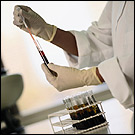|
Iron Overload and Hemochromatosis: Detection and Diagnosis |
|
 Most regular medical check-ups do not include tests to measure the
amount of iron in the body. For that reason, hemochromatosis is often not
identified in people who have the disease. Most regular medical check-ups do not include tests to measure the
amount of iron in the body. For that reason, hemochromatosis is often not
identified in people who have the disease.
If you think you have symptoms like those of hemochromatosis,
(fatigue, weakness, abdominal pain and/or joint pain), or if you
have a close relative who has hemochromatosis, you should ask your health
care provider to check the amount of iron in your blood.
Early detection of iron buildup is important because prompt diagnosis and
treatment of hemochromatosis can help prevent the more serious problems
caused by the disease.
To see if you might be at risk for hemochromatosis, a doctor will take a
complete medical history and give you a physical examination. Having
information about your family’s health history is also helpful.
To check the amount of iron in your body, a doctor can use two simple
blood tests:
- Transferrin saturation (TS) test
- Serum ferritin (SF) test
If these tests show that you have too much iron in your body, you will
need to start phlebotomy (pronounced “fle-bot-o-me”) treatment.
Transferrin Saturation (TS) Test
You should not eat after midnight on the night before your blood is drawn
for the transferrin saturation (TS) test.
If, on an empty stomach, your TS value is greater than 45%, you should
have a serum ferritin test done.
Note that taking any of the following supplements or pills in the day
prior to your blood draw can make TS values higher than normal:
- Multivitamins with iron
- Multivitamins or pills with vitamin C
- Medicinal iron
If you take any of these supplements or pills, you should not use them
for 24 hours before blood is drawn for the TS test.
Serum Ferritin (SF) Test
For information about interpreting the serum ferritin (SF) test, see the
following table.
|
For women |
• If you have not been through menopause, an SF greater more
than 200 ng/mL (nanograms per milliliter) means there is too
much iron in your body.
• If you have been through menopause, an SF value greater than
300 ng/mL means there is too much iron in your body. |
|
For men |
• An SF value greater than 300 ng/mL means there is too much
iron in your body. |
These blood tests, a thorough medical history, and a physical examination
may also help rule out other conditions that could be causing the symptoms.
|
Key Point |
| If you think you have symptoms like
those of hemochromatosis or if you have a close blood relative
who has hemochromatosis, you should ask your health care
provider to check the amount of iron in your blood. |
back to top
|